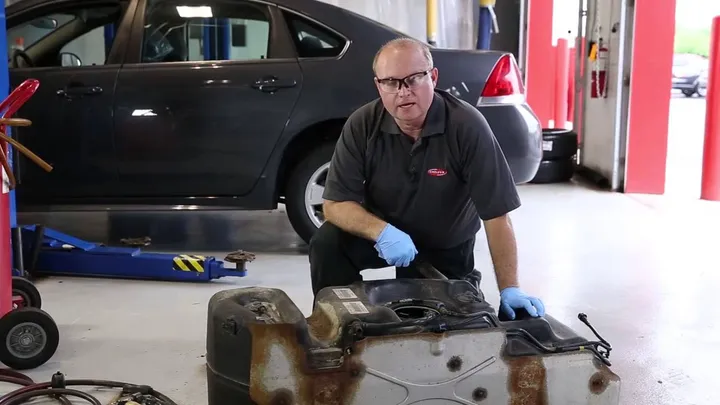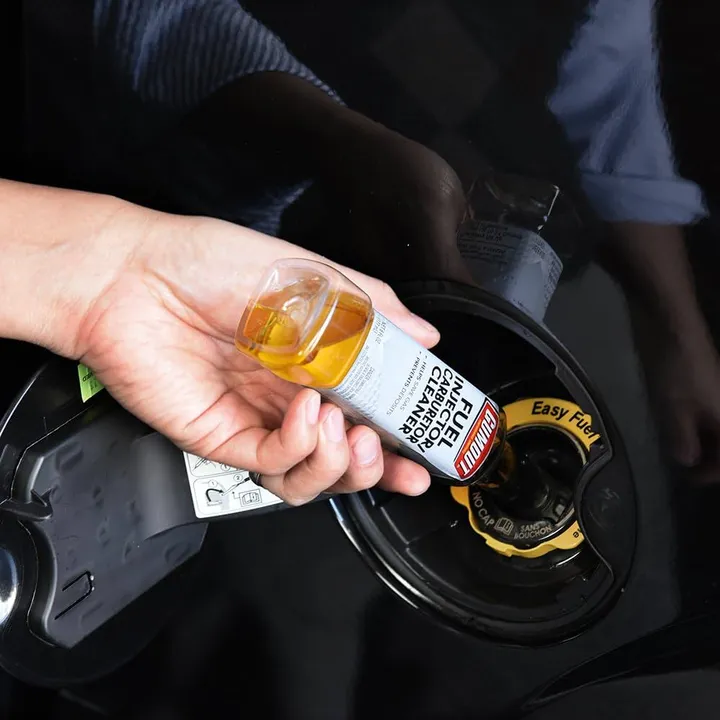


Cleaning a vehicle's fuel tank is an important maintenance task that helps ensure optimal performance and longevity of the fuel system components. Over time, contaminants such as rust, sediment, and debris can accumulate in the fuel tank, leading to issues like clogged fuel filters, fuel pump failure, and decreased fuel efficiency. While removing the fuel tank is the most thorough method for cleaning, it can be a time-consuming and labor-intensive process. Fortunately, there are several methods available to clean a fuel tank without removing it from the vehicle.

Before we dive into the cleaning process, it's crucial to understand the primary causes of fuel tank contamination. Here's a table summarizing the main culprits:
| Cause | Description |
|---|---|
| Sediment Buildup | Over time, dirt, rust particles, and other contaminants can accumulate in the fuel tank, leading to clogged filters and fuel lines. This buildup can occur due to rust from the tank's interior, dirt or debris entering through the fuel filler neck, or even from the fuel itself. |
| Water Contamination | Water can find its way into the fuel tank through condensation, leaks, or even during refueling if the fuel source is contaminated. Water in the fuel tank can lead to corrosion, fuel degradation, and microbial growth, further exacerbating the problem. |
| Microbial Growth | Certain types of bacteria and fungi can thrive in the fuel tank environment, especially when water is present. These microorganisms feed on the hydrocarbons in the fuel, leading to the formation of sludge and clogged filters, severely impacting the vehicle's performance. |
Sediment buildup is a common issue in fuel tanks, especially in older vehicles or those that have been sitting idle for an extended period. This buildup can occur due to various reasons:
Rust particles from the tank's interior
Dirt or debris entering through the fuel filler neck
Contaminants present in the fuel itself
Over time, these sediments can accumulate and cause clogged filters, restricted fuel flow, and potential damage to the fuel system components.
Water can enter the fuel tank through various means, such as:
Condensation: Moisture in the air can condense inside the fuel tank, especially in areas with high humidity or temperature fluctuations.
Leaks: Any cracks or holes in the fuel tank or fuel system components can allow water to seep in.
Refueling: If the fuel source is contaminated with water, it can be introduced into the fuel tank during refueling.
Water in the fuel tank can lead to several issues, including:
Corrosion of metal components
Fuel degradation and separation
Microbial growth, leading to sludge formation
Certain types of bacteria and fungi can thrive in the fuel tank environment, especially when water is present. These microorganisms feed on the hydrocarbons in the fuel, leading to the formation of sludge and clogged filters. Some common types of microbes found in fuel tanks include:
Acetobacter species
Hormoconis species
Cladosporium species
Microbial growth can severely impact the vehicle's performance by restricting fuel flow, clogging filters, and potentially damaging fuel system components.
Before attempting to clean the fuel tank, it's crucial to inspect and diagnose the issue properly. Here are the steps I typically follow:
Check the fuel filter: A clogged or dirty fuel filter can be an indication of contaminants in the fuel tank.
Inspect the fuel lines: Look for any signs of debris or blockages in the fuel lines.
Check for water contamination: Use a water-detecting paste or dipstick to check for the presence of water in the fuel tank.
Listen for unusual noises: Gurgling or sputtering sounds from the fuel tank or fuel system can indicate contamination or blockages.
If the fuel tank is contaminated, you may notice the following signs:
| Sign | Description |
|---|---|
| Difficulty starting the engine or rough idling | Contamination can interfere with the fuel delivery and combustion process, leading to starting issues or rough idling. |
| Reduced fuel efficiency or power | Clogged filters and restricted fuel flow can result in reduced fuel efficiency and engine power output. |
| Stalling or hesitation during acceleration | Debris or sludge in the fuel system can cause interruptions in fuel delivery, leading to stalling or hesitation during acceleration. |
| Frequent fuel filter clogging or replacement | If the fuel filter needs to be replaced more frequently than usual, it could indicate a contamination issue in the fuel tank. |
Once you've identified the issue, it's time to tackle the cleaning process. Here are the steps I follow for different types of contamination:
Locate the fuel tank drain plug or valve.
Place a suitable container underneath to catch the drained fuel and sediment.
Open the drain plug or valve and allow the fuel and sediment to drain out.
Once the tank is drained, inspect the interior for any remaining debris or rust.
Use a fuel tank cleaning solution or a long-handled brush to agitate and remove any remaining sediment.
Rinse the tank thoroughly with clean fuel or a solvent.
Replace the fuel filter and any damaged fuel lines.
Use a water-absorbing product or fuel desiccant to remove any water from the fuel tank.
Follow the manufacturer's instructions for proper application and disposal.
If water contamination is severe, consider draining and flushing the fuel tank as described in the sediment removal process.
Use a biocide or fuel treatment product specifically designed to kill and prevent microbial growth in the fuel system.
Follow the manufacturer's instructions for proper application and dosage.
Consider draining and flushing the fuel tank if the microbial growth is severe.
Always work in a well-ventilated area and avoid open flames or ignition sources.
Dispose of drained fuel and contaminated materials properly, following local regulations.
Replace any damaged or corroded fuel system components.
Consider using a fuel tank sealer or liner to prevent future rust and contamination.
After successfully cleaning the fuel tank, it's essential to take preventive measures to avoid future contamination.

Replace fuel filters according to the manufacturer's recommended schedule.
Inspect and clean the fuel tank periodically, especially if the vehicle has been sitting idle for an extended period.
Use fuel additives or stabilizers to prevent fuel degradation and microbial growth.
Avoid topping off the fuel tank to prevent spills and minimize air exposure.
Use high-quality fuel from reputable sources to minimize contaminants.
Avoid letting the fuel tank run too low, as this can allow sediment to enter the fuel system.
The cost of cleaning a fuel tank without removing it can vary depending on the severity of the contamination and the methods used. Here's a table with approximate cost estimates:
| Item | Cost Range |
|---|---|
| Fuel tank cleaning solution or biocide | $10 to $30 |
| Fuel filter replacement | $10 to $50 |
| Fuel line replacement (if needed) | $50 to $200 |
| Professional fuel system cleaning service | $100 to $300 |
It's important to note that these costs can vary based on the make and model of the vehicle, the availability of parts, and the labor rates in your area. Additionally, if the fuel tank needs to be removed or replaced due to severe damage or corrosion, the costs can be significantly higher.
Cleaning a fuel tank without removing it can be a cost-effective and efficient solution for addressing contamination issues. By following the proper inspection, diagnosis, and repair procedures outlined in this comprehensive guide, you can restore your vehicle's fuel system to optimal condition and prevent further damage.
Remember, regular maintenance and proper usage are key to preventing future contamination and ensuring your vehicle's longevity. If you're ever unsure or encounter a particularly challenging situation, don't hesitate to seek professional assistance from a qualified mechanic.
Difficulty starting the engine, rough idling, reduced fuel efficiency, stalling during acceleration, and frequent fuel filter clogging are common signs of a contaminated fuel tank.
Water can enter the fuel tank through condensation, leaks in the tank or fuel system components, or by refueling with contaminated fuel.
Common microbes found in fuel tanks include Acetobacter species, Hormoconis species, and Cladosporium species.
You can use a water-detecting paste or dipstick to check for the presence of water in the fuel tank.
A fuel tank cleaning solution helps agitate and remove sediment buildup from the interior of the fuel tank.
Using a biocide or fuel treatment product designed to kill and prevent microbial growth, and regularly replacing fuel filters can help prevent future microbial growth.
Work in a well-ventilated area, avoid open flames or ignition sources, and dispose of drained fuel and contaminated materials properly.
Using a fuel tank sealer or liner can help prevent future rust and contamination in the fuel tank.
The cost range for professional fuel system cleaning services is typically between $100 to $300.
Fuel filters should be replaced according to the manufacturer's recommended schedule for your vehicle.

Sarah isn't your average gearhead. With a double major in Mechanical Engineering and Automotive Technology, she dived straight into the world of car repair. After 15 years of turning wrenches at dealerships and independent shops, Sarah joined MICDOT to share her expertise and passion for making cars run like new. Her in-depth knowledge and knack for explaining complex issues in simple terms make her a valuable asset to our team.











